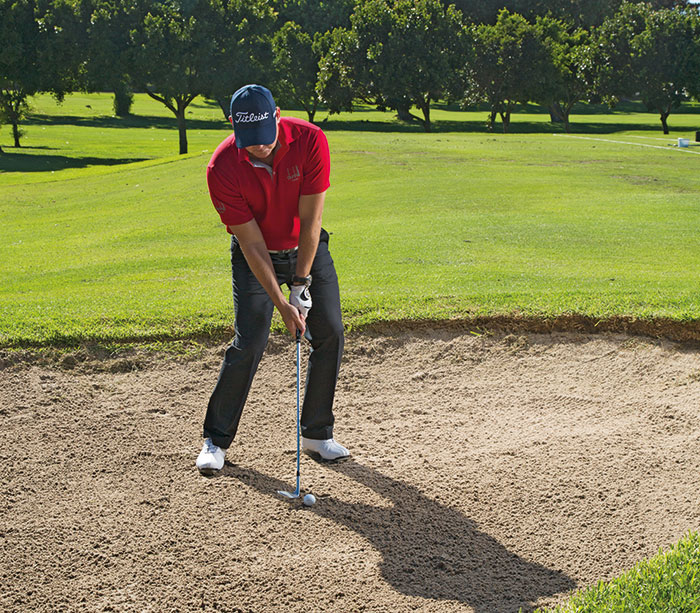We’ve all been there before – you’re at the range and your mate asks you for a little help with their swing. This series of tips helps you find the quick solutions to some of golf’s most common swing ailments. This month Grant Hepburn looks at some of the reasons behind your mate’s bunker battles.
In most cases, professional golfers would prefer to be in the greenside bunker than the rough. This is because they have such good technique from the sand that they, more often than not, are able to get the ball close to the hole. Unlike a ball that is lying in some grassy rough, with bunker shots they don’t need to hit the ball absolutely perfectly, because they will be making contact with the sand first.
For most ammies, however, simply getting out of the sand is hard enough – never mind jamming it next to the pin. And for some, the fear of being in the sand is almost suffocating.
But with a bit of help, an improved technique and plenty of practice, you should not only be able to escape the sand easily enough, but start thinking about making sand saves.
It is important to remember throughout these tips that, for bunker shots, the sand wedge is designed not to hit the ball directly, but the aim is to hit the sand about an inch behind the ball. The explosion of the sand provides the energy to move the ball rather than the impact of the club. Like every other shot in golf, it is important to commit to the shot and accelerate through it.
The secret is in the setup
Most ammies will know that a good bunker setup sees the ball positioned forward of centre and the stance slightly open. By swinging along the line of your feet, you are able to cut under the ball and produce a softer, splashing shot.
When it comes to the setup, the key is to make sure that your weight is on your left side (for right-handed golfers), but ensure that your but spine is tilted to the right.
This is demonstrated in the correct picture where I hold the shaft of my club in front of my chest – I can easily check to see that the shaft (and therefore my spine) is tilted the correct way.
The correct spine tilt helps the ball to get up in the air but my weight being on my left ensures that the club enters the sand near to the ball. If my weight is too far to the right – as shown in the incorrect pictures – then too much sand will be taken. The club will take a deep divot and the ball will most likely stay in the sand.
Make a good turn
Many amateurs make the mistake of only using their arms in the backswing, but for the bunker shot it is important to make a mini swing where your body still turns. In a good backswing, you shouldn’t be able to see the chest at the top of the swing – so if you can see your mate’s chest you will know that he has not turned the shoulders correctly with the arms
Mind the gap
Looking down the line, one should not be able to see any gap between my arms and my body. In other words, the arms need to swing around the body in the backswing, as shown in the correct image. Many amateurs make the mistake of simply picking their arms up in an effort to cut across the ball, but this is incorrect – since the slightly open stance will take care of the swing path, there is no need to try and take the arms out and away from the body to create the correct swing path. Simply stand with a slightly open stance and then swing the arms around the body. This will allow the sand to be splashed out on a shallow path instead of a deep, cutting hack into the bunker.
Check the belt
When it comes to the followthrough, once again the body is important. Your belt buckle should end up facing the target, as this move allows the arms to swing all the way through and help the ball fly out of the bunker. A common mistake that ammies make is to use only the arms to try and hoist the ball out of the bunker – but this stops the swinging motion and the shot cannot be executed successfully. In this case, as the incorrect image shows, the belt would not have turned at all.








